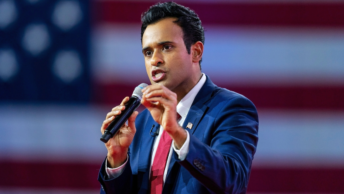The 2018 U.S. midterm elections, in which Republicans lost 40 or so House seats, sent many Republican strategists reeling because of the erosion of suburban voters, especially college-educated white female voters. Republicans kept the Senate, but the loss of suburban congressional districts should be a matter of concern. As Republicans look ahead, three questions need to be answered: How severe were these losses in the suburbs? In order to regain suburban, female or youth voters, should Republican candidates adjust their platform and revise their basic principles? And, most important for Mindszenty Report readers, are social and religious issues relevant to today’s voters?
Republican Losses in Perspective
Following the midterm returns, Senator Lindsey Graham (R-SC) expressed the common sentiment in the Republican Party when he told Fox News, “We’ve got to address the suburban women problem, because it’s real.” Graham added that “style does matter, and sometimes it can drown out substance.”
Graham’s concerns with losses in suburban districts are legitimate. Of the 41 congressional districts that Democrats flipped, 38 were suburban. Surprisingly, some of the country’s biggest flips came in the South, in suburbs of cities such as Houston, San Antonio, Austin, Memphis, Charlotte, Oklahoma City and Atlanta.
In addition, Democrats made gains in upscale Morris County, NJ, Beaver County and Fayette County outside Pittsburgh, four suburban counties neighboring Philadelphia, Rochester County, NY and already blue suburbs around the nation’s capital in Maryland and Virginia. In affluent DuPage County outside of Chicago, there was a 10-point change from 2016. Republicans lost in large metropolitan suburbs in places such as Orange County, CA, where Republicans lost four seats. Democrats now control all six congressional seats in that county, as well as every congressional district in Washington state except one.
All told, Democrats made gains in suburban counties and cities with high-income and college-educated voters. Voters went more Democratic in 80 suburban counties and cities compared to 2016. In the majority of these areas, Democrats showed single-digit percentage point increases, but more than 20 suburban districts showed a double-digit swing in favor of the Democrats.
Although pundits focused on the desertion by white college-educated female voters of Republican candidates in favor of Democratic candidates, evidence suggests that the problem was larger than just women shunning Republican candidates. There is, no doubt, a gender gap that predated Donald Trump’s election to the presidency in 2016. Overall, a majority of American women vote Democratic. When the totals are broken down, however, white women supported Trump in 2016, and college-educated white female voters gave Trump nearly half their votes.
Suburban Men Shifted Too
The swing of Republican suburban voters cut across gender lines and party lines. The Republican losses in the suburbs were due to a greater extent to a loss of votes by independent suburban men. Voters are classified as “independent” if they do not give their allegiance to any political party. Independent female voters were already more likely to support Democrats before the 2018 election. The greater shift among independent voters in 2018 came from male voters. This shift can be seen by comparing the 2014 independent male vote with the 2018 independent male vote. In 2014, independent male voters gave Republicans a 19-point advantage. In 2018, independent men gave Democrats a seven-point margin. These independent male voters, it should be noted, helped win the presidency for Trump in 2016, and their switch to Democratic in 2018 is why Republicans lost so many seats in the House.
Referendum on Trump?
Midterm elections tend to go against the incumbent party, and this was the case in 2018. Some Republicans tried to downplay the midterm losses by pointing out that Clinton and Obama fared worse in their midterms. This is factually correct; nevertheless, the 2018 midterm results should be a wake-up call for Republicans as they look to 2020. Voter turnout was one of the largest in recent history. Both Democrats and Republicans turned out in high numbers. Democrats, though, turned out in higher numbers and their candidates were well-funded.
Democratic candidates hit on two themes that struck a chord with voters: health care and education. Democrats charged that Republicans wanted to take away guaranteed insurance coverage of pre-existing health care conditions in their plan for reforming Obamacare, a false allegation also made by the late Republican Senator from Arizona, John McCain, when he provided the deciding vote against the proposed health care bill brought before the Senate last year.
Democrats hammered away in districts with older voters by warning of the so-called “senior healthcare tax.” Republican legislation called for seniors to pay higher deductibles because they have higher health care costs and use the system more than do younger people. The result was that even in strong Republican districts with a high percentage of seniors, Democrats made gains.
Democrats seized on the education issue as well. Teacher protests were organized in key red states such as Oklahoma and Arizona demanding that these states spend more money on education—i.e., higher teacher salaries. Who could stand against education for children? It was a no-win for Republicans, and as a consequence Republican governors and state legislatures gave in to demands to increase teacher salaries. The teacher protests and walkouts appeared well orchestrated by Democratic and teachers union operatives. But Republicans should be able to tell a better story about education. More money does not mean a better education for children, and state funds need to be spent better. Nonetheless, Democrats came across to the voters as reformers, even though in actuality teachers unions represent the status quo of failed public education across the country.
President Trump campaigned heavily to support Republican candidates. He used the immigration crisis to fire up his base. He called for an end to birthright citizenship and described the migrant caravan on the border as an “invasion.” The Republican base ranked immigration as one of their top concerns. For many Democratic and independent voters, health care and education were the top priorities.
Exit polls and later voter analysis showed that many suburban voters, particularly women, were turned off by President Trump’s overall tone. As GOP strategist and CEO of Republican Mainstreet Partnership Sarah Chamberlain told The Hill, “What happened in a lot of our suburban districts . . . came down to ‘hey you guys have done great policy, but we still—we’re not crazy about the tweets.’” Many of these voters were especially put off by President Trump’s tweet three weeks before the midterms labeling adult-film actress Stormy Daniels “Horseface.”
Republicans immediately tried to distance themselves from President Trump’s remarks. Speaker Paul Ryan condemned the tweet, declaring, “There is no place for that kind of language. . . . He should not have said that.” Republican Chris Stewart from Utah described the attack as “unpresidential” and “rude,” distracting voters from Republican accomplishments. GOP strategist Liz Mair went even further, commenting, “It’s just another tweet in an ongoing pattern. When you constantly behave in an outrageous fashion, people get immunized and numb to that.”
President Trump’s language appeals to his most avid supporters, who like to see a Republican president returning fire. But many voters who crossed party lines to vote Democratic told pollsters that the tone of President Trump’s tweets turned them off.
How the Kavanaugh Hearings Played Out
For some voters alienated by President Trump’s tweets, the Senate hearings on Trump’s Supreme Court nominee Brett Kavanaugh reinforced an image that the Republican Party disrespects women, culturally and politically. However unfair this view, many suburban voters, especially women, believed Christine Blasey Ford’s allegations of sexual misconduct by Kavanaugh when he was a teenager. A national poll conducted by Quinnipiac University (which leans liberal) shortly before the election found that 61 percent of college- educated white women believed Ford over Kavanaugh. In this poll, 58 percent of well-educated women said the Senate should reject his nomination.
The Kavanaugh hearings and his brutal examination by Democratic Senators fired up the Republican base to turn out for the election. The abuse Kavanaugh took at the hearings, threats to his family, and unsubstantiated and conflicting accusations of Ford rallied Republican voters. Senator Lindsey Graham became a hero among conservatives when he told Kavanaugh, “You got nothing to apologize for. When [you see Justices] Sotomayor and Kagan, say hello because I voted for them. I’d never do to them what [was] done to this guy.” Echoing the feelings of many who watched the hearings, he blasted the Democratic senators, “This is the most unethical sham since I’ve been in politics.”
College-educated white female voters were disposed to believe Ford, however farfetched her charges, because they are much more likely than white women without college degrees to say that women face discrimination. Slightly more than half of college-educated white men also believed Ford over Kavanaugh, while non-college-educated white men overwhelmingly believed Kavanaugh. During the 2016 presidential election, a majority of college-educated women forgave President Trump’s remarks about women and his opponents because they did not want Hillary Clinton to become president. Still, many women including those who voted for Trump were left with lingering feelings that President Trump was not sympathetic to women.
Does Culture Matter Anymore?
The loss of the House was a serious setback for Republicans and revealed the party’s weak support among female, suburban, college-educated, young and minority voters. Given the losses, Republicans will feel pressured to move to the center on issues to accommodate moderate voters. Furthermore, there will be pressure on some candidates to distance themselves from President Trump. This tendency will intensify, one suspects, over the next two years as the Democratic-controlled House launches investigations into every aspect of President Trump’s personal, financial and public life. Republican congressional, state and local candidates, however, will find it difficult to maintain distance from the candidate heading the party’s ticket.
In order to placate moderate voters, some Republicans will want to minimize the so-called “social issues” such as abortion, transgender rights, alternative family structures, and coercive measures against free exercise of religion. The assumption will be that religious voters—traditional Catholics and evangelical Protestants—are already in the bag, so to speak, for the Republican Party.
This might be the case, but ignoring social issues would be a bad strategy for a couple of reasons. First, as a general rule candidates should stand on principle and assume that voters will respect them for their honesty. Voters want authenticity from their candidates. If Donald Trump and Bernie Sanders taught us anything in 2016 it is that voters might not agree with every proposal these candidates made, but voters appreciated, even admired, that Trump and Sanders, albeit in different ways, were telling voters where they stood.
The Moral Principles at Stake
A larger issue looms beyond just political gain: the cultural issue of where American stands as a nation. If the government does not protect life, what else can it stand for? Life is a basic human right, and without the protection of life there are no other meaningful rights.
As America has become more secularized, fundamental rights such as the right of a baby to be born and the right of a child to have a mother and a father are being marginalized as fringe “religious” issues. Religious voters have been portrayed in the media and popular entertainment as hypocrites and fanatics trying to impose their antiquated and irrelevant values on a post-industrial society. Traditional Jews and Christians have found themselves under attack in the schools, universities, media, and popular and high culture. Progressives like to proclaim that they are fighting for social justice and that defenders of traditional moral values are reactionaries, just as the defenders of slavery were reactionaries.
Black slavery was abolished in America because it confronted a more powerful and fundamental American foundational principle—that all humans are created equal in the eyes of the Lord. Conservatives understand traditional culture to be based on enduring principles arrived at though centuries of transmitted wisdom: God-given rights to life, liberty and the pursuit of happiness; the rule of law; the nuclear family and the reality of gender differences; and the protection of individual rights including religious conscience.
The left’s agenda is to destroy traditional values. This has been evident since the French Revolution when the Jacobins declared war on the Catholic Church and Christianity. The great Irish conservative Edmund Burke understood this. The first thing Communists did when they came to power in the Soviet Union, China and other countries was to suppress religion and replace it with a religion of the state. Progressives today seek to replace traditional values with new constructions built on vague sentiments of social justice and new meanings for gender and family structures.
Long-standing rituals such as standing for the national anthem are replaced by kneeling in the name of social justice. American history is dismissed as one of sin, and not progress in protecting individual opportunity and rights. Progressives understand that without tradition and national rituals that express belief in individual rights, the importance of the family, the rule of law, and patriotism, citizens are left adrift socially and culturally with only the state, overseen by an elite political caste, to impart values to the nation.
As the 2020 election nears, Republicans will be confronted with the choice of standing for principle or capitulating to a secular culture. The temptation to abandon stands on moral principles in an increasingly secularized nation, especially pronounced among many suburban voters, will be severe. Modern conservatism and the success of the Republican Party were built largely among suburban voters.
As Neil J. Young, a journalist writing in The Atlantic shortly before the 2018 midterms, observed, “college-educated white women have formed a substantive bloc for the GOP, the key constituency in establishing the party’s hold on suburbs and exurbs across the country.” He noted that the modern conservative movement “owed much to Phyllis Schlafly,” who maintained that a healthy culture built on a strong two-parent family is necessary to economic prosperity and political liberty. Suburban women should understand this.
This belief, contrary to progressives, is as essential for America today as it was in the late 20th century. Republicans can change the tone of this message, re-crafting it for today’s voter, including college-educated women, minority and young voters, but the principle remains the same. Republicans and conservatives need to remember this in the turbulent days ahead.









Very opinionated. Light on citing research source. I didn’t care for it.